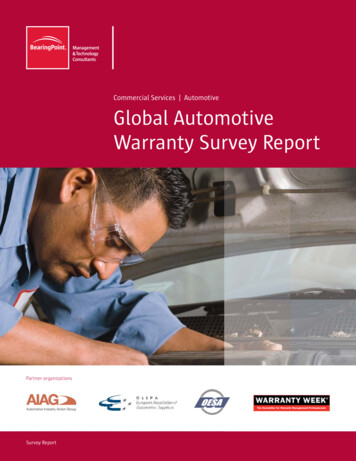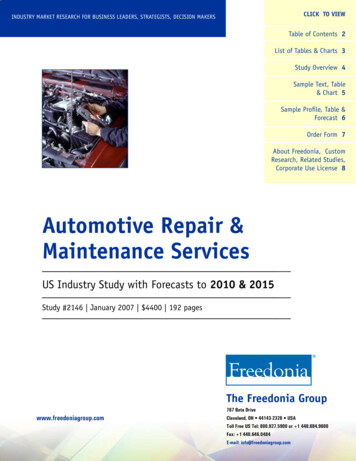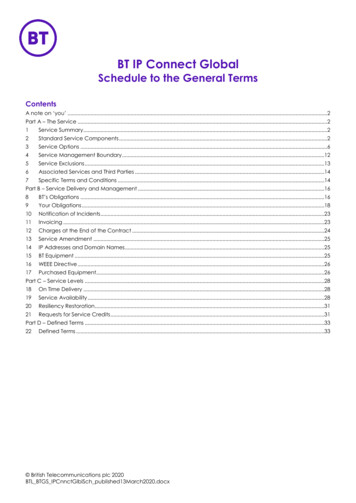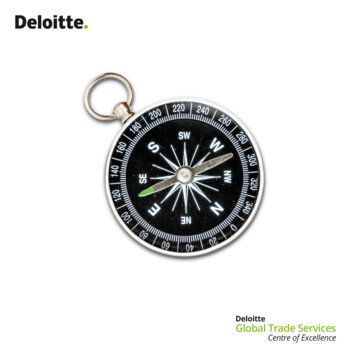
Transcription
Commercial Services AutomotiveGlobal AutomotiveWarranty Survey ReportPartner organizationsSurvey Report
Most importantly, there was a clear desire amongstOEMs and suppliers to work together to make warrantymanagement the kind of proposition that can helpboth sides weather current and future storms.2Insight Journal
ForewordAs the automotive industry’s second century unfolds, its key players are confronted by awide range of challenges. Fuel prices are at an all-time high. The green agenda is highlyprominent, with increasing regulatory focus on emissions and fuel efficiency. And againstthe backdrop of a global credit crisis, the fight for customer spend and loyalty remainsfiercely competitive.Along with these challenges, warranty management remains one of the industry’s mostimportant and pressing issues. Car manufacturers and their dealers use warranties to winand retain customers. Those customers, in turn, expect to be given or be able to negotiatelonger warranty coverage. Suppliers are often caught in the middle—pressed to match thebumper-to-bumper warranties offered by original equipment manufacturers (OEMs), butoften the recipients of these longer warranties’ resulting cost burdens.In late 2007 we at BearingPoint decided that the time was right for a major primaryresearch effort on the subject of warranty management. How are companies around theworld rising to the warranty challenge? What responses are considered most critical andmost feasible? And of paramount importance, how can all of the key stakeholders worktogether to create a warranty environment in which OEMs, dealers, suppliers andcustomers all come out ahead?BearingPoint is a world leader in helping the automotive industry address its most burningimperatives; and as such was well positioned to launch such a study. Our professionalswork closely with most of the world’s major car and truck manufacturers, as well asnumerous first- and second-tier suppliers. However, we recognized that our analysis wouldbe strengthened by a collaborative research effort with the world’s foremost automotiveindustry organizations. We are therefore delighted that the following report has beenenhanced by the insights and assistance of the Original Equipment Suppliers Association(OESA), Automotive Industry Action Group (AIAG), European Association of AutomotiveSuppliers (CLEPA) and Warranty Week magazine.It is a measure of the importance that the automotive industry places on the issue ofwarranty management that responses to our survey were strong. Most came from seniorexecutives. About one third of our respondents said they are their organization’s topwarranty executive. And virtually all have primary warranty responsibility either for theentire company or for a specific division or regional entity.From this highly qualified group of respondents, we learned a great deal—thatresponsibility for warranty management is fragmented across departmental silos andOEM/ supplier organizations, that there are divergent views as to the key barriers tosuccess, and that strong financial underpinnings such as specific cost targets and total costof ownership calculations are often lacking. Yet we also detected strong consensus inmany vital areas. Most importantly, there was a clear desire amongst OEMs and suppliersto work together to make warranty management the kind of proposition that can help bothsides weather current and future storms.We hope you find the following report both informative and helpful, and that you’ll feelfree to contact us with questions, comments or additional insights.James RodgerVice president, Global Automotive leaderBearingPointSurvey Report 3
Commercial Services AutomotiveWinning through collaboration:Observations and insights on warrantymanagement in the automotive industryIn this reportForeword31. Key findings62. The warranty organization103. Warranty duration,costs and incidents134. Gauging the effectivenessof warranty managementpractices195. Making warrantymanagement improvements266. The road ahead30About the BearingPointAutomotive Practice34Survey Development Partners36Acknowledgements38Lagging sales in North America andEurope. Stricter regulations. Industryrestructuring. Increased competition.More product complexity. These are theauto industry’s stark realities—conditionsthat present vehicle manufacturers andtheir supply chain partners with dramaticopportunities and challenges. Eachreality also affects and complicates thetask of warranty management. Now morethan ever, warranty management has adirect impact on the profitability of anoriginal equipment manufacturer (OEM),its dealer network and other supplychain partners.Further increasing the complexity ofwarranty management is its broadeningscope. Warranties reflect far more thanan OEM’s or supplier’s confidence in itsproduct. They are also a selling strategy, avital collaboration point, a cornerstone ofcustomer retention, a data managementhot spot, and a key contributor to riskand risk analysis. OEMs extend warrantiesto emphasize product quality and combatcompetitors. Suppliers work across tiersto keep increased complexity fromcompromising reliability and raisingwarranty costs. Both sides seek betterways to leverage diagnostic data.Estimates of global spend on warrantyclaims frequently run between 45 billionand 50 billion. In the United States,automotive manufacturers and theirsuppliers spent almost 13 billion onwarranty claims in 2006, according toWarranty Week.1 This represents a modestincrease from 2005, about 1.6 percent.However, the small rise masks a varietyof growing concerns that OEMs andsuppliers at all tiers have about warranty1“Automotive Warranties,” Warranty Week, May 15, 5.html4 Survey Reportmanagement. For example, warrantycosts are not dropping even thoughthe number of claims has been goingdown. This clearly implies higher repaircosts and/or increased labor rates.Moreover, there are many complicated,big-picture questions: Whose involvementand leadership are needed to increasecollaboration? What more can or shouldcompanies be doing to improve warrantycost-effectiveness? Where do collaboration breakdowns occur most frequently?Why do they happen? When should newanalytics be invoked? How can we usewarranty management to improve theoverall quality and reliability of parts,systems and vehicles?BearingPoint’s Automotive practicerecently teamed with the OriginalEquipment Suppliers Association (OESA),Automotive Industry Action Group (AIAG),European Association of AutomotiveSuppliers (CLEPA) and Warranty Weekmagazine to address the above concerns.Via an online survey, our goal was to findout how OEMs and suppliers at all tiersand from all geographies perceive thewarranty challenge, and what solutionsthey are using or investigating to improvewarranty programs and reduce costs.We also expected survey input fromOEMs and suppliers to stimulate newdiscussions about, and insights into, howthese groups can expand their workingrelationship to increase value forconsumers, raise returns for stakeholders,and deliver lower costs and profitablegrowth for themselves. That feedback—enriched by insights from BearingPoint,OESA, AIAG, CLEPA and key industryexecutives—is interwoven throughoutthis report’s six sections.
1. Key findingsThe picture emerging from our researchis both positive and negative. On the plusside, OEMs and suppliers have mademeasurable warranty-related improvements over the past three years. Warrantyincidents are down. J.D. Power ratings areup. Increased product complexity andmore stringent customer demands havebeen met with new tools and well-focusedinitiatives. Moreover, respondents arelargely united in their view of whatfurther changes are most needed andhow important it is to work togetherearlier in the warranty managementprocess. Generally speaking, the watchword is collaboration. Virtually allrespondents look forward to working moreclosely within and across organizations.The not-unexpected downside is theindustry’s operational shortcomings.Respondents’ own assessments pointto a warranty management processwith room for significant and ongoingimprovement. Numerous factorscontribute to this appraisal:Responsibility for warranty managementis fragmented across departmentalsilos and between OEM and supplierorganizations. Among survey respondents,45 percent of OEMs and 25 percent ofsuppliers have discrete warranty organizations. Cross-functional processes arelimited, and resources are often strained.The industry recognizes the barriers towarranty improvement that this approachcreates. Many initiatives are underway toimprove the effectiveness of the currentsystem. However, partners still are notincluded as often or early as needed,and usable information rarely flows freelyenough to support dramatic processimprovements or significant costreductions. We believe that a moreholistic, cross-functional infrastructure isneeded at most enterprises.Perspectives on key issues varydramatically. OEMs and suppliers havevastly different views about the largestobstacles their organizations face inimproving warranty performance. OEMs’top issues are “resource shortages,”“purchase cost versus total cost ofownership” and “lack of product designinvolvement.” Suppliers’ top issues are“collaboration with the OEM/supplier,”“lack of diagnostic data” and “lack ofproduct design involvement.”Along these same lines, when supplierswere asked, “Do your OEMs provideenough information on service events,returned parts, and diagnostic andwarranty data for you to perform effectiveroot cause analysis?” Seventy-five percentof suppliers answered “no.” In addition,77 percent of suppliers said that it takesone month or longer to receive partsand/or data. Seven percent never receiveparts, and eight percent never receivedata. A more ingrained culture ofcollaboration at the design and troubleshooting stages is clearly needed, as arethe introduction and adoption of standardtemplates or mechanisms for sharingservice event data (including the components that would be found in a typicalwarranty claim).A more ingrained culture of collaboration at the design and troubleshooting stagesis clearly needed, as are the introduction and adoption of standard templates ormechanisms for sharing service event data (including the components that wouldbe found in a typical warranty claim).Survey Report 5
Commercial Services AutomotiveThe “collaboration dichotomy” (low levelsof collaboration despite widespread agreement that more collaboration is critical)poses a significant challenge. Supplierssimply are not getting the data they needquickly enough. Survey results do showthat data-sharing initiatives have beenlaunched, but significant and measurableimpact has not been widely observed.Win-win approaches are lacking. Ourresearch notes a progressive transfer ofdesign/release responsibility from OEMsto suppliers. In the past, OEMs assumedmost design/release responsibilities.However, 66 percent of respondingsuppliers now have design/releaseresponsibility for at least some parts.Since that practice is usually accompaniedby the introduction or enhancement ofa warranty cost-sharing program, oneresult of this shift is that many OEMs areseeing their warranty costs fall, whilemany suppliers are seeing or predictingincreased costs. There are many missingPoint of view“The reason collaboration is critical is that it is the only way we can gain access tothe data necessary to correct issues and then build this new knowledge into ourfuture products.”Daniel PaterraVice president,Manufacturingand Quality,Transmission SystemsBusiness Unit,BorgWarner, Inc.We are fortunate that warranty professionals in the automotive industry are willingto objectively rate the reality of the situation. This research project has done a goodjob of revealing the insights of our automotive warranty colleagues for the benefit ofimproving warranty management. They have provided a frank assessment and thisdocument identifies where opportunity for improvement exists.In general, the study reveals we need more collaboration. The reason collaboration iscritical is that it is the only way we can gain access to the data necessary to correctissues and then build this new knowledge into our future products. The surveyindicates that the necessary information doesn’t flow in the most efficient manner.Different formats, insufficient sample sizes, long lead times and partial data sets areimpeding the efficient flow of solutions. The open collaboration of all participants inthe chain is required to surface the information and develop speedy solutions towardsthe goal of improving consumer vehicle experiences.Take the issue of No Trouble Found—“the designation for a part replaced during aservice event that, when analyzed by the maker, meets all the requirements of a goodpart.” The survey indicates that, among suppliers, the most frequent classificationgiven to warranty parts associated with an incident is NTF. However, NTF is not theproblem; it is the beacon that points to the need for more diagnostic data and systemexpertise in root cause determination. NTF is basically an information problem, not apart or system problem.The bottom line is that collaboration—from consumers and dealers to suppliers andOEMs—is the common denominator for all warranty-related improvements. A sharedapproach to solving problems, increasing knowledge and ensuring continuousimprovement benefits everyone.6 Survey Report
BearingPoint’s message to OEM and supplier executivesThe picture emerging from the research is that, by the industry’s own assessments, the current state ofwarranty management is often ineffective. This appears to be compounded by a number of factors: Responsibility for warranty management is distributed across OEM and supplier organizations. OEMs and suppliers recognize that there have been improvements in warranty-related collaboration,yet there is a clear and urgent need to raise levels of collaboration further and support them withreliable processes and systems infrastructures. Suppliers are hamstrung by a lack of vital data from OEMs or protracted delays in receiving that data.Where this information is provided, it often appears too late in the cycle to be effectively utilized.If the “as-is” picture painted by the research seems gloomy, there are also indications that, if left unchecked,the situation could get worse—particularly for suppliers. The research highlights a progressive transfer ofdesign/release responsibility from OEMs to suppliers. As a result OEMs are seeing their warranty costs fall,while suppliers predict their costs will increase.Yet there are encouraging signs. OEMs and suppliers largely agree on the imperatives that must be addressedto move forward productively: Increase communication and collaboration between the OEM and its suppliers. Provide more (and timelier) diagnostic data to suppliers for root cause analysis. Increase collaboration among product design teams. Accelerate development of early warning systems. Assign sufficient resources to manage warranty. Ensure the timely and efficient communication of warranty claims, parts and data among partners.We hope that this report will remind industry leaders and key stakeholders in the warranty managementprocess that they must work together to improve collaboration and increase timely sharing of critical data.links in this equation, but the four mostprominent may be lack of early warningsystems, untimely data sharing, fewstandardized warranty metrics andan insufficient focus on total cost ofownership. Each of these is criticalto replacing zero-sum politics withwin-win relationships.Clear warranty cost targets are rare.Setting absolute cost targets is verydifficult, particularly for suppliers, whichhave limited ability to influence “noise”in the process. That noise (issues such asdata integrity, limited information,misdiagnoses, inability to send matingcomponents or the supposedly failedcomponent back for analysis, andvariance in repair procedures) canseriously impact costs. More control onthe part of suppliers could significantlychange the dynamic, as could agreementson shared analysis strategies and models.No Trouble Found (NTF) is a big issue. Thetop contributors to warranty incidents forOEMs are “product design” (cited by 58percent) and “assembly process capabilityat supplier” (50 percent). For suppliers,it’s “NTF” (cited by 61 percent), “manufacturing process capability” (53 percent)and “product design” (50 percent). On theSurvey Report 7
Commercial Services Automotiveone hand, high NTF levels reflect anincreased number of complex vehiclesubsystems since, as the complexity ofthese subsystems increases, so does thedifficulty of determining problems’ rootcauses. The aforementioned “noise” inthe warranty process also contributes toNTF problems. Even though NTF oftenmeans different things to differentorganizations (see the sidebar, “Gettingto the Heart of NTF,” on page 18), thereis little disagreement that more collaboration among OEMs, suppliers and dealersis needed to reduce NTF levels. It istypically easier to determine the causeof a problem if it is flagged early by highlyqualified people. New end-to-endapproaches to diagnostics and communication can help make that happen. Newforms of advanced training in diagnosticsand quality improvement at the dealerlevel could also reduce NTF levels, whileincreasing contextual information aboutincidents.Detection-to-correction cycles are athorny issue. By nearly identical margins(3.5 to 1) OEMs and suppliers feel thattheir overall detection-to-correction cycleshave improved over the past three years.Still, more progress is clearly called for inareas such as:Problem definition: There is no industrywide definition of what constitutes thedetection-to-correction cycle. Somecompanies start at the point that an issuehas been prioritized and assigned forfurther analysis/resolution. Othersinclude the time from the first report ofa particular issue. While the latter wouldseem to be better, it is usually the casethat issues encountered within theservice process do not become evident toanyone other than the dealer until atleast several days have passed andmultiple claims have been logged.8 Survey ReportProblem identification: Among suppliers,53 percent complete the problemidentification phase within seven days,another 19 percent within 21 days andanother six percent within a month.OEMs fared less well: 29 percent withinseven days, and the remainder in oneto two months or more. This, too, mayreflect a lack of close collaborationwith suppliers.Problem Diagnosis: Among suppliers,29 percent complete the diagnosis phasewithin seven days, another 49 percentwithin 21 days and another nine percentwithin a month. OEM performance is abit longer: 28 percent within 14 days,and the remainder in one to two monthsor more.Problem resolution: Among suppliers,six percent complete the problemresolution phase within seven days,another 23 percent within 21 daysand another 18 percent within a month.No OEM completes problem resolution inless than one to two months.As noted earlier, both suppliers and OEMsbelieve that collaboration betweenpartners has become more effective overthe previous three years. Still, the issue ofhow to work together to share data andapply knowledge to support continuousimprovement could be the auto industry’smost pressing warranty-related problem.Adoption of standardized terms, methodologies and tools—backed by appropriatecontract language—also is needed toimprove the situation. Becoming“customer-focused” and “incident ratefocused” (rather than “responsibility- andcost-focused”) will help drive increasedcollaboration. In addition, joint supportteams, improved systems and more openaccess to data and parts will contribute toa faster, more effective and less costlywarranty management process.
Survey demographicsIn late 2007, researchers at BearingPoint, OESA, AIAG,
auto industry’s stark realities—conditions that present vehicle manufacturers and their supply chain partners w

![Global Commercial Strategy [L6M2] - CIPS](/img/2/l6m2-sample-answer-20guide-fv-20v3.jpg)









